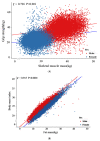An Inverse Relation between Hyperglycemia and Skeletal Muscle Mass Predicted by Using a Machine Learning Approach in Middle-Aged and Older Adults in Large Cohorts
- PMID: 34069247
- PMCID: PMC8156777
- DOI: 10.3390/jcm10102133
An Inverse Relation between Hyperglycemia and Skeletal Muscle Mass Predicted by Using a Machine Learning Approach in Middle-Aged and Older Adults in Large Cohorts
Abstract
Background: Skeletal muscle mass (SMM) and fat mass (FM) are essentially required for health and quality of life in older adults.
Objective: To generate the best SMM and FM prediction models using machine learning models incorporating socioeconomic, lifestyle, and biochemical parameters and the urban hospital-based Ansan/Ansung cohort, and to determine relations between SMM and FM and metabolic syndrome and its components in this cohort.
Methods: SMM and FM data measured using an Inbody 4.0 unit in 90% of Ansan/Ansung cohort participants were used to train seven machine learning algorithms. The ten most essential predictors from 1411 variables were selected by: (1) Manually filtering out 48 variables, (2) generating best models by random grid mode in a training set, and (3) comparing the accuracy of the models in a test set. The seven trained models' accuracy was evaluated using mean-square errors (MSE), mean absolute errors (MAE), and R² values in 10% of the test set. SMM and FM of the 31,025 participants in the Ansan/Ansung cohort were predicted using the best prediction models (XGBoost for SMM and artificial neural network for FM). Metabolic syndrome and its components were compared between four groups categorized by 50 percentiles of predicted SMM and FM values in the cohort.
Results: The best prediction models for SMM and FM were constructed using XGBoost (R2 = 0.82) and artificial neural network (ANN; R2 = 0.89) algorithms, respectively; both models had a low MSE. Serum platelet concentrations and GFR were identified as new biomarkers of SMM, and serum platelet and bilirubin concentrations were found to predict FM. Predicted SMM and FM values were significantly and positively correlated with grip strength (r = 0.726) and BMI (r = 0.915, p < 0.05), respectively. Grip strengths in the high-SMM groups of both genders were significantly higher than in low-SMM groups (p < 0.05), and blood glucose and hemoglobin A1c in high-FM groups were higher than in low-FM groups for both genders (p < 0.05).
Conclusion: The models generated by XGBoost and ANN algorithms exhibited good accuracy for estimating SMM and FM, respectively. The prediction models take into account the actual clinical use since they included a small number of required features, and the features can be obtained in outpatients. SMM and FM predicted using the two models well represented the risk of low SMM and high fat in a clinical setting.
Keywords: C-reactive protein; fat mass; grip strength; machine learning; platelet; prediction model; skeletal muscle mass.
Conflict of interest statement
The authors declare that they have no conflicts of interest to disclose.
Figures






Similar articles
-
Development and Validation of an Insulin Resistance Predicting Model Using a Machine-Learning Approach in a Population-Based Cohort in Korea.Diagnostics (Basel). 2022 Jan 16;12(1):212. doi: 10.3390/diagnostics12010212. Diagnostics (Basel). 2022. PMID: 35054379 Free PMC article.
-
Skeletal Muscle Mass and Fat Mass Relationships With Physical Fitness Test Performance in Law Enforcement Recruits Before Academy.J Strength Cond Res. 2021 May 1;35(5):1287-1295. doi: 10.1519/JSC.0000000000003918. J Strength Cond Res. 2021. PMID: 33900262
-
On the Use of Machine Learning Models for Prediction of Compressive Strength of Concrete: Influence of Dimensionality Reduction on the Model Performance.Materials (Basel). 2021 Feb 3;14(4):713. doi: 10.3390/ma14040713. Materials (Basel). 2021. PMID: 33546376 Free PMC article.
-
A Prediction Model for Osteoporosis Risk Using a Machine-Learning Approach and Its Validation in a Large Cohort.J Korean Med Sci. 2023 May 29;38(21):e162. doi: 10.3346/jkms.2023.38.e162. J Korean Med Sci. 2023. PMID: 37270917 Free PMC article.
-
Effect of Skeletal Muscle and Fat Mass on Muscle Strength in the Elderly.Healthcare (Basel). 2018 Jun 26;6(3):72. doi: 10.3390/healthcare6030072. Healthcare (Basel). 2018. PMID: 29949913 Free PMC article.
Cited by
-
Association of Plant-Based and High-Protein Diets with a Lower Obesity Risk Defined by Fat Mass in Middle-Aged and Elderly Persons with a High Genetic Risk of Obesity.Nutrients. 2023 Feb 20;15(4):1063. doi: 10.3390/nu15041063. Nutrients. 2023. PMID: 36839421 Free PMC article.
-
Association of Polygenic Variants with Type 2 Diabetes Risk and Their Interaction with Lifestyles in Asians.Nutrients. 2022 Aug 6;14(15):3222. doi: 10.3390/nu14153222. Nutrients. 2022. PMID: 35956399 Free PMC article.
-
Height-Related Polygenic Variants Are Associated with Metabolic Syndrome Risk and Interact with Energy Intake and a Rice-Main Diet to Influence Height in KoGES.Nutrients. 2023 Apr 4;15(7):1764. doi: 10.3390/nu15071764. Nutrients. 2023. PMID: 37049604 Free PMC article.
-
Energy Intake-Dependent Genetic Associations with Obesity Risk: BDNF Val66Met Polymorphism and Interactions with Dietary Bioactive Compounds.Antioxidants (Basel). 2025 Jan 30;14(2):170. doi: 10.3390/antiox14020170. Antioxidants (Basel). 2025. PMID: 40002356 Free PMC article.
-
Inverse association of daily fermented soybean paste ("Jang") intake with metabolic syndrome risk, especially body fat and hypertension, in men of a large hospital-based cohort.Front Nutr. 2023 Mar 13;10:1122945. doi: 10.3389/fnut.2023.1122945. eCollection 2023. Front Nutr. 2023. PMID: 36992908 Free PMC article.
References
-
- Bonaccorso G. Machine Learning Algorithms. Packt Publishing Ltd; London, UK: 2017.
Grants and funding
LinkOut - more resources
Full Text Sources
Research Materials

